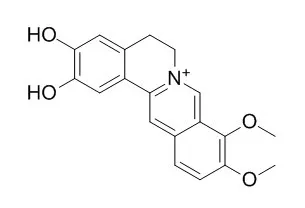| Description: |
Demethyleneberberine, which is composed of a potential antioxidant structure, could penetrate the membrane of mitochondria and accumulate in mitochondria either in vitro or in vivo.Demethyleneberberine suppresses CYP2E1, hypoxia inducible factor α, and inducible nitric oxide synthase, which contributes to oxidative stress and restored sirtuin 1/AMP-activated protein kinase/peroxisome proliferator-activated receptor-γ coactivator-1α pathway-associated fatty acid oxidation in chronic ethanol-fed mice. |
| In vitro: |
| J Pharmacol Exp Ther. 2015 Jan;352(1):139-47. | | Demethyleneberberine, a natural mitochondria-targeted antioxidant, inhibits mitochondrial dysfunction, oxidative stress, and steatosis in alcoholic liver disease mouse model.[Pubmed: 25362106] | Excessive alcohol consumption induces oxidative stress and lipid accumulation in the liver. Mitochondria have long been recognized as the key target for alcoholic liver disease (ALD).
Recently, the artificial mitochondria-targeted antioxidant MitoQ has been used to treat ALD effectively in mice.
METHODS AND RESULTS:
Here, we introduce the natural mitochondria-targeted antioxidant Demethyleneberberine (DMB), which has been found in Chinese herb Cortex Phellodendri chinensis. The protective effect of Demethyleneberberine on ALD was evaluated with HepG2 cells and acutely/chronically ethanol-fed mice, mimicking two common patterns of drinking in human. The results showed that Demethyleneberberine, which is composed of a potential antioxidant structure, could penetrate the membrane of mitochondria and accumulate in mitochondria either in vitro or in vivo. Consequently, the acute drinking-caused oxidative stress and mitochondrial dysfunction were significantly ameliorated by Demethyleneberberine. Moreover, we also found that Demethyleneberberine suppressed CYP2E1, hypoxia inducible factor α, and inducible nitric oxide synthase, which contributed to oxidative stress and restored sirtuin 1/AMP-activated protein kinase/peroxisome proliferator-activated receptor-γ coactivator-1α pathway-associated fatty acid oxidation in chronic ethanol-fed mice, which in turn ameliorated lipid peroxidation and macrosteatosis in the liver.
CONCLUSIONS:
Taking these findings together, Demethyleneberberine could serve as a novel and potential therapy for ALD in human beings. |
|






 Cell. 2018 Jan 11;172(1-2):249-261.e12. doi: 10.1016/j.cell.2017.12.019.IF=36.216(2019)
Cell. 2018 Jan 11;172(1-2):249-261.e12. doi: 10.1016/j.cell.2017.12.019.IF=36.216(2019) Cell Metab. 2020 Mar 3;31(3):534-548.e5. doi: 10.1016/j.cmet.2020.01.002.IF=22.415(2019)
Cell Metab. 2020 Mar 3;31(3):534-548.e5. doi: 10.1016/j.cmet.2020.01.002.IF=22.415(2019) Mol Cell. 2017 Nov 16;68(4):673-685.e6. doi: 10.1016/j.molcel.2017.10.022.IF=14.548(2019)
Mol Cell. 2017 Nov 16;68(4):673-685.e6. doi: 10.1016/j.molcel.2017.10.022.IF=14.548(2019)